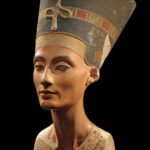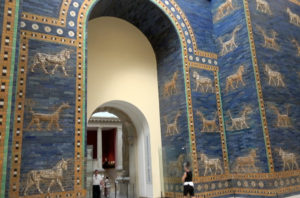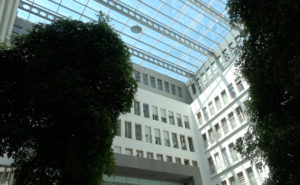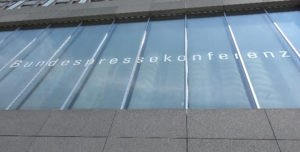Our last day in Berlin prior to leaving for Lithuania focused on churches and museums. The Kaiser Wilhelm Memorial Church was close enough to our hotel to walk to in the morning.
Kaiser Wilhelm Memorial Church
Heavily damaged in WWII bombing, the church tower is a stark visual reminder of the kind of damage done to Berlin and Germany, and it has been left in the condition you see to be that reminder. There are also new church buildings surrounding the tower, so the congregation is active.
Original construction of the church began in 1891. Kaiser Wilhelm II built it to honor his father, Wilhelm I.
Here’s video (1:48).
Museum Island
Museum Island (Museuminsel) is a UNESCO World Heritage Site with five museums and the Berlin Cathedral. It’s actually the north end of an island in the middle of the River Spree. Many of the museums were damaged in WWII and you’ll see examples in a couple of videos below. As the island had been in East Berlin postwar, restoration of the museums and collections did not really begin until the 1990s.
(With only a few hours available, our museum tour was relatively brief. It’s certainly worth at least a day.)
The first video focuses on the Neues Museum, built in 1843-55, but not reopened after reunification until 2009.
 The building houses the Egyptian museum, including the famous bust of Queen Nefertiti. (Photography of the bust by museum visitors is not allowed. This is an “official” photo.) There are also portions of another major collection, artifacts from the Stone Age and later prehistoric eras from the Museum of Pre- and Early History.
The building houses the Egyptian museum, including the famous bust of Queen Nefertiti. (Photography of the bust by museum visitors is not allowed. This is an “official” photo.) There are also portions of another major collection, artifacts from the Stone Age and later prehistoric eras from the Museum of Pre- and Early History.
The video (2:00) opens with the Lustgarten (Pleasure Garden) and Altes Museum.
Pergamon Museum
The Pergamon Museum houses an antiquity collection, the Middle East museum, and the museum of Islamic Art. It is notable for the monumental scale of several exhibits, including the Ishtar Gate of Babylon.

Video (1:55).
Berlin Cathedral
“Berlin Cathedral” is much easier than the official name: Evangelical Supreme Parish and Collegiate Church. Construction of the current church began in 1893 and it was opened in 1905. The building was damaged in WWII, but East Germany permitted the start of reconstruction in 1975 due to the infusion of West German currency.
Not without taking some ideological revenge, however. East Germany destroyed the northern wing of the original building, compared by some to the Medici Chapel in Florence, Italy, because it had been a memorial to the Hohenzollern dynasty, which ruled Germany for many years. (There are four caskets of Hohenzollerns on the church’s main floor. Many more are in the lower level of the church. Fascinating stuff below, but conditions were not suitable for video.)
Restoration renewed after reunification, and efforts to restore the dome and surrounding cupolas continue today.
Julia and I visited around the time of the daily prayer service at 6 pm, which lasts about half an hour and requires visitors to be seated, with no photography allowed. The time features brief sermons and longer selections from the magnificent organ in the church.
Most of the video (2:34) is accompanied by music from that organ. I cheated a little and turned on the video camera, which simply sat on the pew and collected audio.
Bundespressekonferenz
Between visits to the Kaiser Wilhelm Memorial Church and Museum Island, we joined two new friends, Michael and Cornelia Günther, at the Bundespressekonferenz (BPK) building for lunch. The BPK (Federal Press Conference) is a union of full-time journalists who report principally for German media. Also in the building, located near the Reichstag and other government buildings, are members of the Association of Foreign Press in Germany (VAP).
In contrast to the U.S. and many other countries, the BPK is the “host” of press conferences by German government officials. BPK “invites” officials and they come to the building. Only BPK and VAP members can participate and ask questions. I believe German Chancellor Angela Merkel makes an annual appearance.
Michael is an independent multimedia producer, director, etc. Among other projects, he is working with the Canaris family and Heiko Suhr on a documentary about Admiral Canaris. Cornelia (Connie) is a correspondent for The Economist.

We visited both of their offices and they treated us to lunch in the very nice courtyard of the BPK building. In The Economist office, we were introduced to Vendeline von Bredow, European business and finance correspondent. Ms. von Bredow had spent time in Chicago as the magazine’s Midwest correspondent. Michael pointed out that Ms. von Bredow was a direct descendent of Otto von Bismarck, first Chancellor of the German Empire in the late 19th century. :0
While short of the record set the day before, I was still quite active. Steps were 19,616 for 6.5 miles. Says I climbed 17 floors and I can’t quite figure out where that happened.
On to Lietuva. Back in Berlin in a week.

